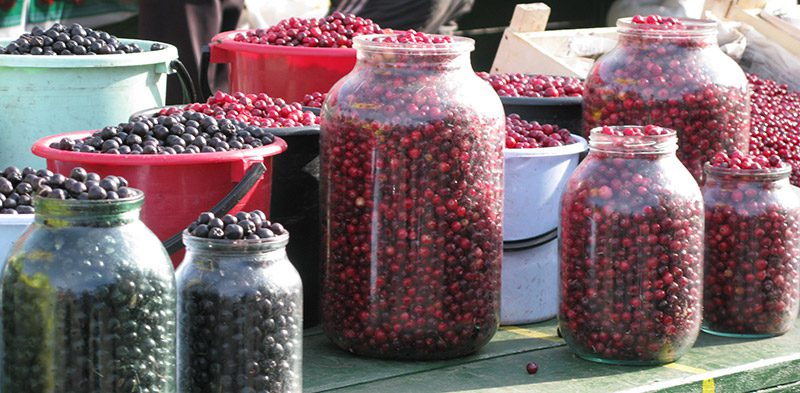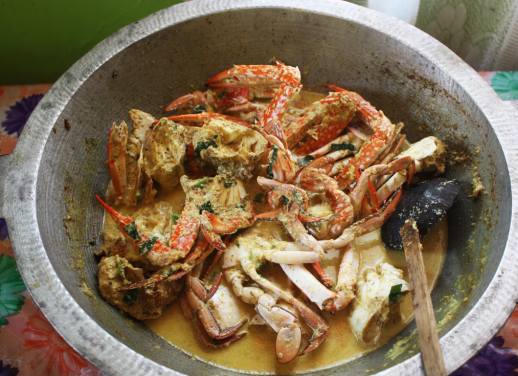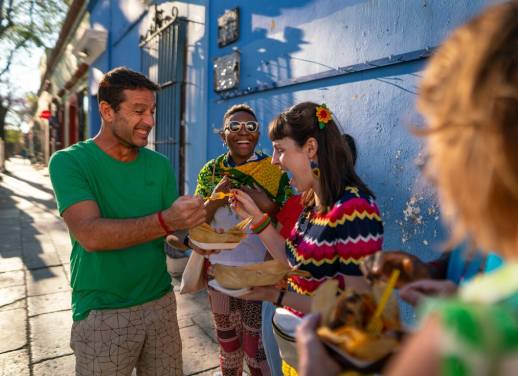The first Russian foods to come to mind are probably caviar and borscht, but in my homeland there are many more regional delicacies to discover.
When you travel to Russia here are five local foods that you won’t want to miss giving a try…
5. Akroshka
This is a Kvas-based cold soup. Kvas is fermented sour-sweet drink made from rye bread and since the Kvas itself is a very unusual drink for guests, Akroshka will probably taste also very strange.
In Russia we love our summer soups. During the hot seasons it helps you to cool down. When it’s too hot and you have not got an appetite, this cold and sour soup is a perfect choice.
Ingredients may vary, but most likely there will be sausage, cucumber, egg, potato, green onion and sour cream. We chop some herbs, like dill, and add them to soup just before serving. It is considered most appropriate to have Akroshka for lunch, but in summer in country houses some prefer it all day long.
The interesting fact is that drivers don’t eat Akroshka. Kvas, the main ingredient, is very low in alcohol, but if you eat a lot of Akroshka in the hot weather it could tip you over the limit. So, why risk it with the traffic police?
4. Salyanka
Salyanka means ‘salty thing’ from the Russian ‘sol’ (salt). It is a typical traditional leftover meal, like having cold Italian pizza the next day.
Even as the name suggests, this soup has few special qualities other than the salt. There are key ingredients such as sausage and meat, potato, tomato or tomato sauce. It also contains pickles and lemon – some say this acts as antiseptic in case the leftover food is past its best. It is also traditionally made with olives and in some regions even with cheese – making it even a closer cousin of the pizza!
Salyanka is usually taken with the short of vodka, to help you digest this weird leftover soup.
3. Syrniki
This is fried quark or cheese pancakes, garnished usually with sour cream, jam or honey. Syrniki are made from creamy quark, mixed with flour, eggs and sugar, sometimes adding vanilla extract. The soft mixture is shaped into cakes, which are fried, generally in vegetable oil. The outside becomes crisp and the center is warm and creamy. They are sweet and served for breakfast or dessert.
Their simplicity has made them very popular, not only in Russia but generally in eastern Europe. The name Syrniki comes from the word ‘syr’ – cheese in Russian. Syrniki means ‘cheese things’ or ‘cheese cakes’ in Russian, although nowadays there are western cheesecakes, which are entirely different and don’t have a Russian translation.
2. Ikra
Ikra means caviar. Russians also use the word ‘caviar’, especially in the country’s south. Here, on the Caspian Sea, there is up to 90 percent of the world’s production of black caviar. The word ‘caviar’ comes from Turkish ‘havyar’.
There is black and red caviar. Red one is almost ten times cheaper and therefore more affordable. One kilogram of red caviar is roughly US$100, while black one is more than US$1000. But even the very expensive black caviar is a beloved Russian meal.
In modern Russia, a huge percentage of caviar is produced illegally, due to the corruption within the fishing industry. Producing caviar is hard to measure and therefore difficult to control.
It is now an open public discussion about the future of the caviar market in Russia, considering responsible production, environment protection, price regulation etc. One of the best solutions is using the small, local fish farmers. They grow fish with ecologically-friendly methods and have helped increase competition within the caviar market.
Now you can buy officially produced black and red caviar in small farmers’ shops. While the prices might be slightly higher, the quality will be better, plus the caviar will be without preservatives and responsibly farmed.
Caviar has been famous in Russia for hundreds of years, but the mass consumption started ironically in western Europe. In 1920’s the Petrossian brothers emigrated from Azerbaijan to France, where they opened the first caviar restaurant, Petrossian Paris. There was a time in Europe when all things Russian were very fashionable, so with this craze came the increase in eating caviar. Russians were also curious about what’s happening in Europe, so the fashion returned to Russia in the early 20th century and has lasted ever since.
1. Bublik
This is a very simple food but one of the most important for Russians. We love this bagel, or doughnut-shaped bread roll.
First mentioned in Russia in XII-th century under the name rogalik, it soon spread all over, from the Tsar’s table to peasant houses.
There are a lot of international connections with bublik. Bagel in States which originated from the Jewish bublik in Odessa (Ukraine) is the most authentic one. But there are also croissants in France and Germany’s pretzel.
Actually, Russian Tsar Peter the First, who was fond of Germany, was the first to bring home the knot-shaped pretzel biscuit. It was given the Russian name krendel, from the German ‘krengel’, which is the verb ‘to bend’. Nowadays there are different bend shapes and names for this pastry in Russia: rogalik, krendel, kalach, baranki, sushki, but the king of them all is bublik.
Of course you can’t just stop at 5 foods in a country with so many great local dishes that are attached to special local traditions. Have you tried any other foods in Russia that you’d recommend?
* Photo of Russian berries by Esther Mueller, for the Intrepid Photography Competition.





